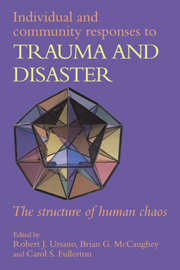Book contents
- Frontmatter
- Contents
- List of contributors
- Foreword
- Preface
- Part I Introduction
- Part II The nature of traumatic stress
- 2 The psychology of terror and its aftermath
- 3 Exposure to traumatic death: the nature of the stressor
- 4 Psychological and psychiatric aspects of technological disasters
- 5 Traumatic effects of accidents
- 6 The human experience of earthquakes
- 7 Psychological effects of toxic contamination
- Part III The role of psychosocial context in responses to trauma and disasters
- Part IV Responses to trauma across the life cycle
- Part V Conclusions
- Index
3 - Exposure to traumatic death: the nature of the stressor
from Part II - The nature of traumatic stress
Published online by Cambridge University Press: 13 October 2009
- Frontmatter
- Contents
- List of contributors
- Foreword
- Preface
- Part I Introduction
- Part II The nature of traumatic stress
- 2 The psychology of terror and its aftermath
- 3 Exposure to traumatic death: the nature of the stressor
- 4 Psychological and psychiatric aspects of technological disasters
- 5 Traumatic effects of accidents
- 6 The human experience of earthquakes
- 7 Psychological effects of toxic contamination
- Part III The role of psychosocial context in responses to trauma and disasters
- Part IV Responses to trauma across the life cycle
- Part V Conclusions
- Index
Summary
Trauma and disasters, both manmade and natural, are frequent occurrences in the present day world: terrorism, plane crashes, earthquakes, industrial accidents, combat and poison gas attacks to name but a few. Common to the occurrence of nearly all disasters and combat is the likelihood of violent death and the presence of human remains – burned, dismembered, mutilated, or relatively intact. Exposure to mass death as well as individual dead bodies is a disturbing and sometimes frightening event. The nature of the stress of exposure to traumatic death and the dead and its relationship to posttraumatic stress disorder and other posttraumatic psychiatric illnesses is not well understood (Breslau & Davis, 1987; Lindy, Green & Grace, 1987; Rundell et al., 1989; Ursano, 1987; Ursano & McCarroll, 1990).
The tasks of body recovery, identification, transport, and burial may require prolonged as well as acute contact with mass death. Recent research has shown that victims, onlookers, and rescue workers are traumatized by the experience or expectation of confronting death in disaster situations (Jones, 1985; Miles, Demi & Mostyn-Aker, 1984; Schwartz, 1984; Taylor & Frazer, 1982). Exposure to abusive violence (Laufer, Gallops & Frey- Woulters, 1984) and to the grotesque (Green et al., 1989) significantly contributes to the development of psychiatric symptoms in war veterans, particularly intrusive imagery (Laufer, Brett & Gallops, 1985; Lifton, 1973).
Despite the widespread recognition that exposure to dead bodies is one of the major stressors in disasters, few studies have examined the psychiatric effects of exposure to dead bodies and body parts.
- Type
- Chapter
- Information
- Individual and Community Responses to Trauma and DisasterThe Structure of Human Chaos, pp. 46 - 71Publisher: Cambridge University PressPrint publication year: 1994
- 13
- Cited by



